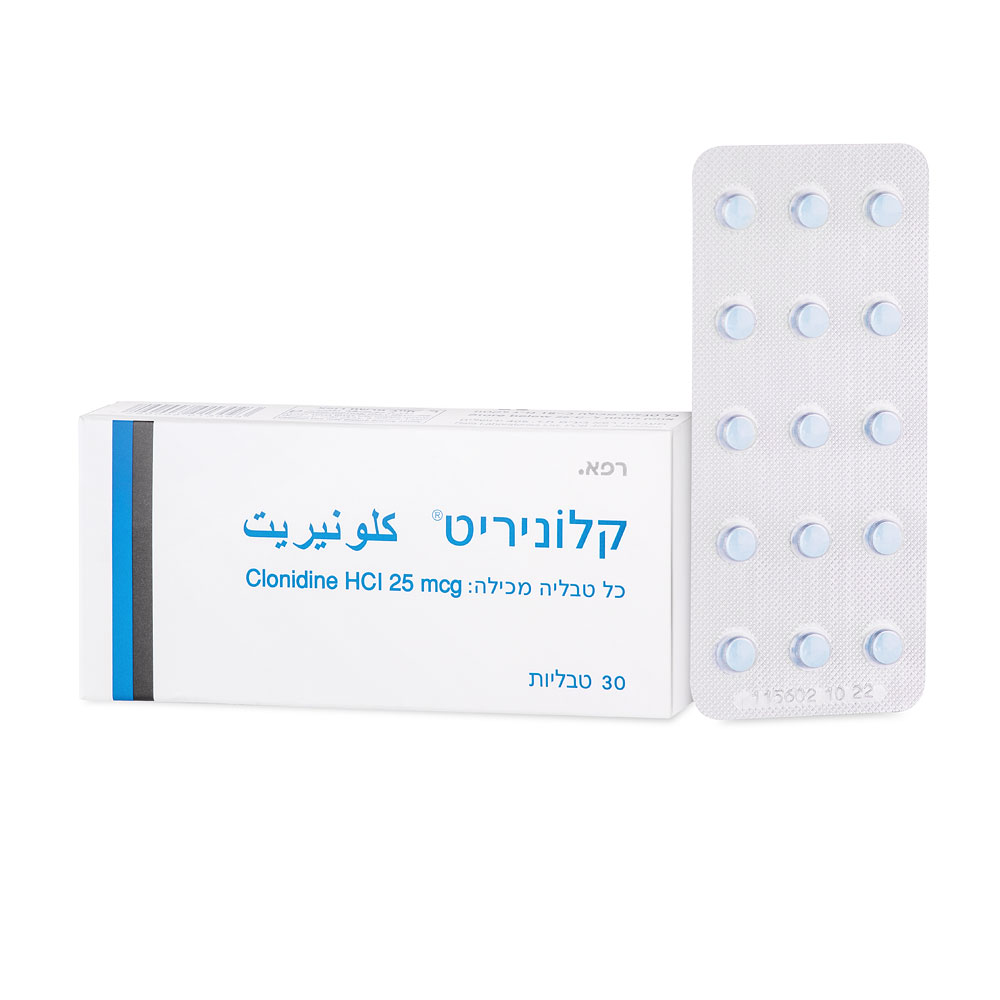Quest for the right Drug

קלוניריט CLONNIRIT (CLONIDINE HYDROCHLORIDE)
תרופה במרשם
תרופה בסל
נרקוטיקה
ציטוטוקסיקה
צורת מתן:
פומי : PER OS
צורת מינון:
טבליה : TABLETS
עלון לרופא
מינוניםPosology התוויות
Indications תופעות לוואי
Adverse reactions התוויות נגד
Contraindications אינטראקציות
Interactions מינון יתר
Overdose הריון/הנקה
Pregnancy & Lactation אוכלוסיות מיוחדות
Special populations תכונות פרמקולוגיות
Pharmacological properties מידע רוקחי
Pharmaceutical particulars אזהרת שימוש
Special Warning עלון לרופא
Physicians Leaflet
Pharmacological properties : תכונות פרמקולוגיות
Pharmacodynamic Properties
5.1 Pharmacodynamic properties Pharmacotherapeutic group: Antimigraine preparations ATC code: N02C X02 Clonidine is an antihypertensive agent, which acts centrally by stimulating alpha2-adrenergic receptors and producing a reduction in sympathetic tone, resulting in a fall in diastolic and systolic blood pressure and a reduction in heart rate. Treatment with Clonnirit diminishes the responsiveness of peripheral vessels to constrictor and dilator stimuli, thereby preventing the vascular changes associated with migraine. The same direct action on peripheral vessels moderates the vascular changes associated with menopausal flushing. Paediatric population The efficacy of clonidine in the treatment of hypertension has been investigated in five clinical studies in paediatric patients. The efficacy data confirms the properties of clonidine in reduction of systolic and diastolic blood pressure. However, due to limited data and methodological insufficiencies, no definitive conclusion can be drawn on the use of clonidine for hypertensive children. The efficacy of clonidine has also been investigated in a few clinical studies with paediatric patients with ADHD, Tourette syndrome and stuttering. The efficacy of clonidine in these conditions has not been demonstrated. There were also two small paediatric studies in migraine, neither of which demonstrated efficacy. In the paediatric studies, the most frequent adverse events were drowsiness, dry mouth, headache, dizziness and insomnia. These adverse events might have serious impact on daily functioning in paediatric patients. Overall, the safety and efficacy of clonidine in children and adolescents have not been established (see section 4.2).
Pharmacokinetic Properties
5.2 Pharmacokinetic properties Absorption and distribution The pharmacokinetics of clonidine is dose-proportional in the range of 75-300 micrograms; over this range, dose linearity has not been fully demonstrated. Clonidine, the active ingredient of Clonnirit, is highly absorbed and undergoes a minor first pass effect. Peak plasma concentrations are reached within 1-3 h after oral administration. The plasma protein binding is 30-40 %. Clonidine is rapidly and extensively distributed into tissues and crosses the blood-brain barrier, as well as the placental barrier. Clonidine is excreted in human milk. However, there is insufficient information on the effect on newborns. Biotransformation and elimination The terminal elimination half-life of clonidine has been found to range from 5 to 25.5 hours. It can be prolonged in patients with severely impaired renal function up to 41 hours. About 70 % of the dose administered is excreted with the urine mainly in form of the unchanged parent drug (40-60 % of the dose). The main metabolite p-hydroxy-clonidine is pharmacologically inactive. Approximately 20% of the total amount is excreted with the faeces. There is no definitive data about food or race effects on the pharmacokinetics of clonidine. The antihypertensive effect is reached at plasma concentrations between about 0.2 and 2.0 ng/ml in patients with normal renal function. The hypotensive effect is attenuated or decreases with plasma concentrations above 2.0 ng/ml.

שימוש לפי פנקס קופ''ח כללית 1994
Prophylaxis of migraine, menopausal flushing
תאריך הכללה מקורי בסל
01/01/1995
הגבלות
תרופה שאושרה לשימוש כללי בקופ'ח
מידע נוסף
